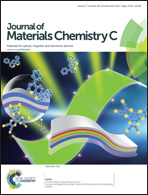Regulation of red to near-infrared emission in Mn2+ single doped magnesium zinc phosphate solid-solution phosphors by modification of the crystal field
Abstract
A series of novel red to near infrared (NIR) emitting (Mg1−xZnx)2.97(PO4)2:0.03Mn2+ (x = 0, 0.2, 0.4, 0.5, 0.6 and 0.8) phosphors were prepared by a solid-state synthesis route at 1000 °C. The X-ray diffraction (XRD) patterns confirmed the (Mg1−xZnx)3(PO4)2 solid solution phase. In addition, the characteristic photoluminescence (PL), decay times and temperature dependent luminescence properties were investigated in detail. The different Mg/Zn ratios resulted in various PL intensities and spectra profiles, which were related to the crystal field strength and local environment of the Mn2+ ions. The probabilities of energy transfer were discussed according to the time-resolved PL spectra. Moreover, the thermal quenching property of the samples was investigated and discussed according to the configuration coordinate diagram. The Mn2+ single doped phosphate (Mg1−xZnx)3(PO4)2 were added to the family of phosphors which can be applied to light emitting diodes as well as in vivo bio-imaging.


 Please wait while we load your content...
Please wait while we load your content...